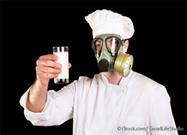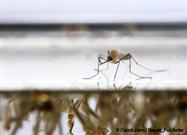Feds Taint Raw Milk Investigation, Soil Farmer’s Reputation

It was around this time last year when reports of deaths and illnesses due to listeria bacteria in Blue Bell ice cream products began to surface. Consuming food contaminated with the bacterium Listeria monocytogenes can lead to a foodborne illness called listeriosis.
In healthy people, the illness is generally mild and causes stomach symptoms, but it can be serious and even deadly for pregnant women and fetuses, older adults, and people with weakened immune systems.
It later was revealed that Blue Bell Creameries found strong evidence of listeria at one of its plants in 2013 but failed to improve its sanitation efforts.1 Today, Blue Bell ice cream is back on the market and, if you didn’t read the headlines, it would appear as though nothing ever happened.
This event is important because it perfectly highlights the double standard and, some might say, the witch hunt regarding raw milk.
A small farm that runs a private membership club selling foods from grass-fed, pastured animals is the latest to have its reputation tarnished due to allegedly false allegations over listeria.
Federal Officials Blame Listeriosis ‘Outbreak’ on Organic Farm
On March 18, 2016, the U.S. Centers for Disease Control and Prevention (CDC) announced a multi-state outbreak of listeriosis linked to raw milk.
The use of the word “outbreak” is a bit of an exaggeration, as to date, only two cases of illness (including one death) have been reported — one in Florida and one in California, both of which occurred in 2014. According to the CDC:2
“Collaborative investigative efforts of state, local, and federal public health and regulatory officials indicate that raw milk produced by Miller’s Organic Farm in Bird-in-Hand, Pennsylvania, is the likely source of this outbreak.”
The announcement claims that although the illnesses occurred in 2014, it wasn’t until January 29, 2016 that the source of the listeria bacteria was revealed. It continued:3
“ … [T]he U.S. Food and Drug Administration informed CDC that whole genome sequencing of Listeria bacteria from raw chocolate milk produced by Miller’s Organic Farm showed that it was closely related genetically to Listeria bacteria from the two ill people described above.”
The CDC even claimed that public health officials interviewed both the ill person in California and family members of the deceased person in Florida and found both people had consumed raw milk before they got sick.
Family of Victim Outraged at CDC, Says She Died of Cancer
The CDC’s investigation sounds legit until you dig a little deeper. Peggy Stevenson, a family member and caregiver of the deceased person claims that the CDC’s statement is false. She said in a press release from the Weston A. Price Foundation:4
“My family member was diagnosed with and died of cancer after a week of chemo … I am outraged that the CDC is using our tragic situation to damage and try to destroy a farm we love and support.”
It does seem strange, too, that there were no other reported illnesses associated with Miller’s Organic Farm — not from listeria or for any other reason.
Pete Kennedy, president of the Farm-to-Consumer Legal Defense Fund (FTCLDF) said, “This is a weak attempt to shut down people’s choices … It shows this bureaucracy is getting more desperate in trying to stop the growing demand for raw milk.”5
CDC Has a History of Twisting Raw Milk Data
Public health agencies had previously stated there were 21 reported illnesses linked to raw milk in Minnesota from 2001 to 2010. But that doesn’t exactly scream “danger,” does it? A CDC study then claimed more than 20,500 Minnesotans were actually sickened.6
How they arrived at this number demands scrutiny. If a person was sickened by campylobacter, E. coli O157:H7 or salmonella during the study period, and had consumed raw milk in the week before, the illness was blamed on raw milk (even though many foods could have caused the illness).
Even using the above criteria, this only raised the illnesses to 530, which were then multiplied based on an assumption that the illnesses were underreported. The Food Business News article then goes on to make a statement that:7
“It seems in this day and age with food safety front and center after Chipotle’s recent situations, and other issues with Listeria in ice cream and cheese and E. coli on leafy vegetables, consumers would want to err on the side of caution.”
This explains the absurdity behind raw milk bans in a nutshell. You can get sick from eating any food — a burrito, a piece of cheese, a fresh salad or, yes, even a bowl of pasteurized ice cream. Yet only raw milk is continually targeted as though it’s a hazardous product.
Media Stirs Up Raw-Milk Controversy in West Virginia
Bills in favor of making it easier for consumers to obtain raw milk are pending in at least a dozen states, from Hawaii to Utah to Wisconsin. One such bill was recently passed in West Virginia, which has historically been one of the least open states to raw milk.
The legislation passed was Senate Bill 387 (SB 387), which allows the distribution of raw milk in the state through herd-share agreements. To celebrate the bill’s passing, some delegates took a drink of raw milk.
Shortly after, a number of the delegates became sick with a stomach bug, which the media quickly picked up and blamed on the raw milk. What was not widely circulated, however, was that many delegates became sick, including some that did not drink the milk.
And, a stomach bug had reportedly been going around for weeks. It wasn’t a case of tainted raw milk at all; it was a case of stomach flu — a virus. Even more outrageous, an investigation was launched to find out who brought the raw milk into the Capitol building.
The delegate responsible (who is said to be the bill’s sponsor, Scott Cadle) received a letter from the state Department of Health and Human Resources stating that he violated West Virginia law by distributing raw milk, but because it’s his first offense he will not be charged.8 Kelli Sobonya, of the West Virginia House of Delegates, told FTCLDF:
“People I speak with are disappointed with the media doing a report on a rumor. Irresponsible journalism. Had they dug deep enough they would have learned of the numerous legislators who were victims of the stomach virus.
One Putnam delegate consumed two glasses of the raw milk and did not get sick. The delegate hospitalized was told it was not a food-borne illness, but a virus.
Many were sick and are still getting sick from being exposed to the intestinal flu. No wonder people are tuning the news out and no longer tuning in. Universities should start re-emphasizing responsible journalism in their curriculum.”
How CAFO Foods Are Spreading Disease
The absurdity of targeting raw milk becomes even clearer when contrasted with the real culprits in many cases of food-borne illness: concentrated animal feeding operations (CAFOs).
The majority of foods that are making people sick are coming not from small organic farms selling raw milk products. They’re coming from CAFOs and the mega-companies that use their products. The Weston A. Price Foundation explained:9
“The FDA has spent years aggressively warning people against drinking raw milk with the claim that it causes hundreds more foodborne illness outbreaks than pasteurized milk. Yet, there have been no cases of listeriosis attributed to raw milk consumption going back forty years, or more. Unlike raw milk, pasteurized dairy has been linked to several deaths in the past ten years.”
Meanwhile, when animals are fed low doses of antibiotics on a daily basis — common practice on CAFOs — it disrupts their natural microbiome, allowing stronger, more antibiotic-resistant bacteria to survive, multiply, and pass on their strength and resistance to future generations.
There’s little doubt that agricultural use of antibiotics for non-medical use is one, if not the, primary driver of antibiotic-resistant disease. Research published in mBio found 80 different antibiotic-resistant genes in five manure samples.10 And again, this antibiotic resistance is being spread not by small organic farmers producing raw milk for their local communities, but by the mega producers raising animals on CAFOs.
This Is an Issue of Food Freedom
Truth be told, many people should not consume dairy whether it is raw or pasteurized, as they are allergic to the milk proteins. Additionally, if you’re insulin resistant, you would likely be better off avoiding raw and pasteurized milk, as it contains the dairy sugar lactose, which can worsen insulin/leptin resistance.
However, if you are healthy and want to drink milk, raw milk from a high-quality source is generally superior in nutrition and flavor. It will also help to decrease the likelihood of insulin spikes from the milk sugar, courtesy of the thick layer of cream on top.
But whether you’re a milk drinker or not, there’s no doubt that you should have the option of choosing what to eat and from what sources. This is why the fight over raw milk stands as a symbol of the much larger fight for food freedom. Who gets to decide what you eat? You? Or the FDA?
If the FDA and other government agencies are allowed to impose their view of “safe food” on consumers, raw milk won’t be the only thing lost — all food will be pasteurized, irradiated, and genetically engineered.
The effort to reclaim our right to buy and consume raw milk is leading the way for everyone who wants to be able to obtain the food of their choice from the source of their choice. So please, get involved! I urge you to get involved with the following action plan to protect your right to choose your own foods:
- Get informed: Visit www.farmtoconsumer.org or click here to sign up for action alerts. To review the raw milk laws in your state, see the Farm-to-Consumer.org’s Raw Milk Nation page.
- Join the fight for your rights: The Farm-to-Consumer Legal Defense Fund (FTCLDF) is the only organization of its kind. This 501(c)(4) nonprofit organization provides a legal defense for farmers who are being pursued by the government for distributing foods directly to consumers. Your donations, although not tax deductible, will be used to support the litigation, legislative, and lobbying efforts of the FTCLDF.
- Support your local farmers: Getting your raw milk from a local organic farm or co-op is one of the best ways to ensure you’re getting high-quality milk. You can locate a raw milk source near you at the Campaign for Real Milk Website. California residents can find raw milk retailers by using the store locator available at www.OrganicPastures.com.
As with all foods, the source matters, and this is just as true with raw milk as any other food. If you’re interested in raw milk, here are tips for finding high-quality raw milk sources.
Get My Best Health Tips for FREE
If you haven’t already, here’s your chance to subscribe to the world’s most popular newsletter! My FREE newsletter is instrumental in changing the lives of many people across the world. If you want to take control of your health then you won’t want to miss out on this opportunity.
When you subscribe I guarantee:
- You’ll be the first to hear about fast-breaking health news and hard-to-find tips for improving your emotional, physical, and spiritual well-being
- You’ll save money because I’m committed to helping you stay healthy, so you won’t need expensive prescription drugs or doctor’s visits so often
- You’ll get straight talk from me in plain English that shatters all the myths and misconceptions about health, aging, and fitness
- You’ll gain unlimited access to free eBooks that can have a profound impact on your health








